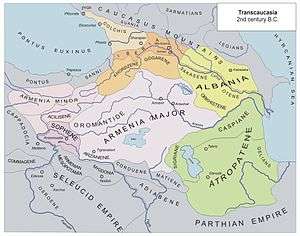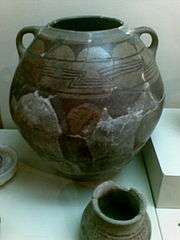Atropatena
| Medya-Atropatena Ατροπατήνη | ||||
| ||||
 | ||||
| Başkent | Qazaka, Vera | |||
| Yönetim | Monarşi | |||
Atropatena (Yunanca: Ατροπατήνη) veya Medya Atropatena, MÖ 4. yüzyılda çoğu bugünkü İran Azerbaycanı ve İran Kürdistanı[2] olarak bilinen bölgede kurulmuş ve başkenti Gazaka kenti olmuş[3] eski bir krallık. Günümüzdeki Azerbaycan'ın tarihi adı Atropatena'dan kaynaklanmıştır[4].
Tarihçe

MÖ 323'te Büyük İskender'in ölümü sonrasında, kurduğu imparatorluğun toprakları İskender'in diadokları (ardılları) arasında bölünmüştür. Eski Ahameniş İmparatorluğu'nun bölgesi olan Medya iki eyalete bölünmüştür: güneyde yer alan Büyük Medya (Medya Magna) ve kuzeyde yer alan Küçük Medya (Medya Atropatena)[5]. Küçük Medya, tüm Medya'nin eski Ahemeniş valisi ve İskender tarafından atanmış naip Perdikas'ın kayınpederi Atropat'ın kontrolüne geçmiş ve Atropat bölgeye öz ismini vermiştir[6]. Kısa süreden sonra Atropat Selevkos İmparatorluğu'na sadakat ödemeden vazgeçmiş ve Medya Atropatena'yı bağımsız bir krallık yapmıştır[6]. Daha sonra Medya önekini kaybederek, sadece Atropena olarak tanımıştır. Atropat'ın Hanedanı bölgeyi birkaç yüzyıl boyunca, önce bağımsız[7], sonra Arşaklılar Hanedanı'nın vasal'ı gibi yönetmıştir[8]. Sonunda Arşaklılar tarafından ilhak olunmuş Atropatena daha sonra Sasani İmparatorluğu'nun kontrolüne geçmiş[9] ve Sasaniler bölgeye yeniden Aturpatakan adını vermiştir. 639 ve 643 yılları arasında Atropatena, Dört Büyük Halifelerden Ömer ibn Hattab'ın yönettiği Hilafetin kontrolüne geçmiştir[10]. Bu dönemde ayrı bir eyalet oluşturan Atropatena/Aturpatkan, stratejik bakımdan büyük önem taşımış ve son olarak Arapçanın etkisiyle Azerbaycan şeklinde değişime uğramıştır.[4]
Kaynakça
- ↑ Nweeya, Samuel K. (1913) (İngiliz). Persia, the Land of the Magi Or the Home of the Wise Men. Philadelphia: The John C. Winston Co.. s. 79. http://books.google.com/books?id=HosNAAAAIAAJ&pg=PA79. "the Caspian Sea and Ghilan bound it on the northeast, and Kurdistan on the southeast"
- ↑ Media Atropatene, Compiled by S.E. Kroll, 1994 in Barrington Atlas of the Greek and Roman World: Map-by-map Directory, Richard J. A. Talbert, Princeton University Press, 2000. Volume 2. pg 1292: "The map approximates the region called by Greek authors Media Atropatene after Atropates, the satrap of Alexander who governed there and later became an independent ruler. The modern name Azerbaijan derives from Atropatene. Originally, Media Atropatene was the northern part of greater Media. To the north, it was separated from Armenia by the R. Araxes. To the east, it extended as far as the mountains along the Caspian Sea, and to the west as far as Lake Urmia (ancient Matiane Limne) and the mountains of present-day Kurdistan. The R. Amardos may have been the southern border.". pg 1293: "Another important site (but not as large as the places just noted) is the famous fire-temple Adur Gushnasp, situated high in the Kurdish mountains at the holy lake of Takht-i Suleiman, and never mentioned by any ancient western source. It"
- ↑ d'Anville, Jean B. B.; Horsley, John (1814) (İngiliz). Compendium of ancient geography. R. M'Dermut and D.D. Anden. s. 22. http://books.google.com/books?id=OqsBAAAAYAAJ&pg=PA22.
- 1 2 Houtsma, M. T.; Arnold, T. W.; Wensinck, A. J. (1993) (İngiliz). E.J. Brill's First Encyclopaedia of Islam, 1913-1936. BRILL. s. 134. ISBN 90-04-09796-1, ISBN 978-90-04-09796-4. http://books.google.com/books?id=GEl6N2tQeawC&pg=PA134.
- ↑ Smith, Philip (1872) (İngiliz). A Smaller Ancient History of the East. New York: Harper & Brothers Publishers. s. 228. http://books.google.com/books?id=SYQoAAAAYAAJ&pg=PA228.
- 1 2 Boyce, Mary; Grenet, Frantz; Beck, Roger (1991) (İngiliz). A History of Zoroastrianism: Zoroastrianism under Macedonian and Roman rule. BRILL. s. 69-70. ISBN 90-04-09271-4, ISBN 978-90-04-09271-6. http://books.google.com/books?id=MWiMV6llZesC&pg=PA69.
- ↑ Liberman, Sherii (2004) (İngiliz). A Historical Atlas of Azerbaijan. Rosen Publishing Group. s. 16. ISBN 0-8239-4497-2, ISBN 978-0-8239-4497-2. http://books.google.com/books?id=R2dwFYio3g4C&pg=PA16.
- ↑ Rawlinson, George (1903) (İngiliz). Story of the Nations: Parthia. New York: G.P. Putnam's Sons. s. 24. http://books.google.com/books?id=wSEYAAAAYAAJ&pg=PA24.
- ↑ Meyer, Eduard (1911) (İngiliz). The Encyclopaedia Britannica. New York: The Encyclopaedia Britannica Company. s. 22. http://books.google.com/books?id=IycqAAAAYAAJ&pg=PA22.
- ↑ Strayer, Joseph R. (1983) (İngiliz). Dictionary of the Middle Ages. Scribner. s. 27. ISBN 0-684-17022-1, ISBN 978-0-684-17022-0. http://books.google.com/books?id=64sYAAAAIAAJ.